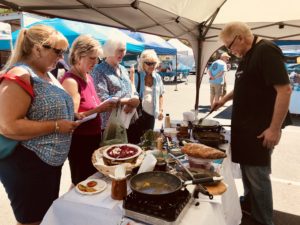
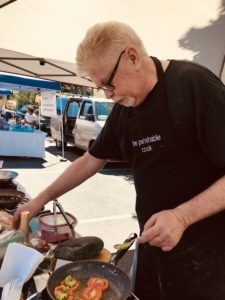
Yesterday I did cooking demos and gave out free samples of four dishes prepared from ingredients on offer right now by the vendors at the Old Saybrook Farmers Market. My purpose was to share my passion for cooking with farmers market ingredients and to publicize theperishablecook.com. This was my first foray out into the real world from the comfort of the online world. It was great fun!
There is no power at the Old Saybrook Farmers Market, so that limits what can be demoed on site. I did four dishes: Courgetti with Basil Pesto; Fried Ripe Tomatoes with Garlic Scape Pesto; Puréed Beet with Yogurt and Za’atar; and Gravlax with Dill Mustard Sauce. I made the two pestos in advance and sautéed the tomatoes and the courgetti in two portable butane burners on site. I made the beet purée in advance, then plated and garnished it on site. I cured the gravlax over the course of the past week, then sliced and plated it on site. The four dishes used garlic scapes, hot house tomatoes, zucchini, basil, beets, salmon and bread from vendors at the market. I gave out recipes for the four dishes, which are shown below with illustrations.
Courgetti with Basil Pesto
This is an awesomely good way to eat zucchini, which the Brits call courgette. You spiralize and saute the squash, which then looks like spaghetti, hence courgetti. Some people call it zudles.
To make it, you need a zucchini and some pesto:
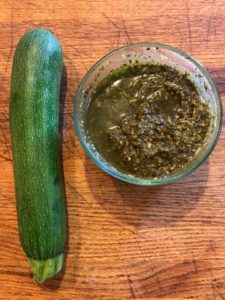
To make the pesto, you need fresh basil, garlic, pine nuts, olive oil and either Parmesan or Romano cheese:
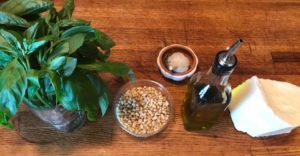
Put a bunch of basil, a couple of peeled garlic cloves and 1/4 cup or so of pine nuts into a food processor until evenly chopped up, then drizzle in 1/3 cup or so of olive oil with the food processor running until you get a smooth paste. Then put that in a bowl and fold in a cup or so of the grated cheese:
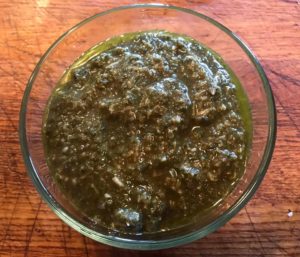
Then you spiralize the zucchini:
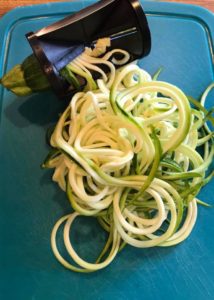
Then sauté it in olive oil for 2-3 minutes…don’t cook it too long or it will release water and become a soggy mess:
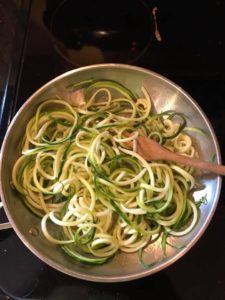
Then add pesto to pan, stir and plate. How much you add depends on how much courgetti you have and how much you like pesto. For me, one batch of pesto based on one bunch of basil will be enough for two medium size zucchini. The batch in the picture below has more pesto than the batch in the picture with the egg. Just a matter of taste. If I am making this for myself, I would just use one zucchini and half (or less) of the pesto. Plenty of other uses for leftover pesto, including more courgetti.
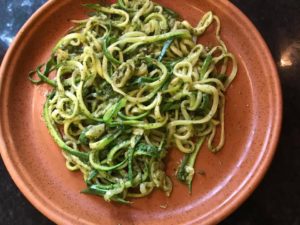
Now you could stop there and have a great meal, but I like to add a poached egg on top. To do that (from Food Lab), bring a pan of salted water to a boil. Crack an egg into a fine sieve over a bowl (this will separate the loose white common in old eggs), lower the heat of the boiling water to low, tip the sieved egg into the pot of just boiled water and poach for 4 minutes, gently stirring the water every so often. You can do this at the same time as you are sautéing the courgetti. After 4 minutes take the egg out of the water with a slotted spoon and nestle on top of the plated courgetti:
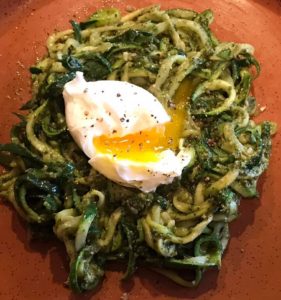
This is a 10 minute meal from start to first bite. Really. I’ve timed myself. I do the pesto first (about 5 minutes) while putting on water to boil. The spiralizing of the courgetti takes about a minute. The poaching of the egg and the simultaneous sautéing of the courgetti takes about 4 minutes. So, 5+1+4=10. If you saute the pine nuts for a minute in a little olive oil before putting them in the food processor with the basil and the garlic, it punches up their flavor. That would add another minute, but who’s counting?
This is so good that I have stopped eating pasta, at least while the good local zucchini and fresh basil lasts.
Fried Ripe Tomatoes with Garlic Scape Pesto
This is the dish I most wanted to demo because garlic scapes are available now from a vendor at the market on Wednesdays, but will soon be gone. Scapes are the shoots of the garlic plant that farmers cut off in late June/early July to concentrate the plant’s energy in the bulb. Most people who look at garlic scapes have no idea what they are or what to do with them.
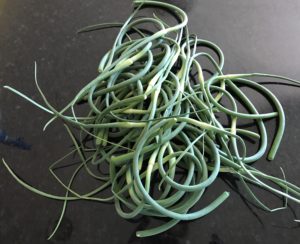
One of the best ways to use them is to make them into pesto, substituting a cup of chopped scapes for the bunch of basil and 2 garlic cloves in the basil pesto recipe above. Otherwise, garlic scape pesto is the same as making basil pesto. You blitz the scapes in a food processor with 1/4 cup pine nuts (toasted a little first), then add in 1/3 cup of olive oil with the processor running to make a smooth paste, then transfer to a bowl and fold in 1/2 cup of freshly grated Parmesan cheese.
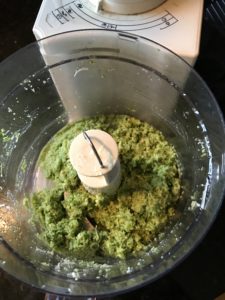
You can use this garlic scape pesto for anything where you would use basil pesto. I particularly like to use it for the Fried Ripe Tomatoes in Jerusalem: A Cookbook by Yotam Ottoenghi and Sammi Tamimi. Their recipe uses a paste of garlic, hot chile and parsley instead of the garlic scape pesto I use here.
Ingredients:
- 1 ripe tomato
- ¼ cup basil or garlic scape pesto
- 2 T olive oil
- Sea salt and pepper
- Toasted slices of a rustic bread
Directions:
- Top and tail the tomato then slice vertically into 1/3 inch slices
- Heat olive oil in sauté pan over moderate heat
- Add the tomato slices, season with sea salt and pepper, and sauté for 1 minute
- Flip, season the slices again with sea salt and pepper, spread some of the garlic scape pesto on each slice, and sauté for another minute
- Turn the slices again and cook for a few more seconds, until soft but not mushy.
- Plate onto toasted slices of a rustic bread
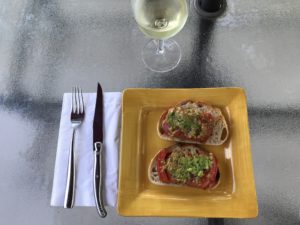
This makes a great appetizer or snack and an awesome savory breakfast.
Puréed Beets with Yogurt and Za’atar
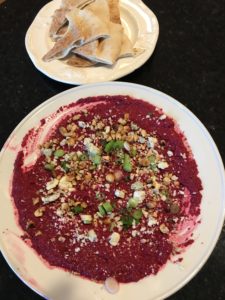
This recipe is also based on one in Jerusalem: A Cookbook by Yotam Ottolenghi and Sami Tamimi, which is my favorite cookbook and a particularly good one for cooking from farmers market ingredients. Za’atar is a Middle Eastern spice mix consisting of powdered dried hyssop leaves, ground sumac, toasted sesame seeds and salt. You can find it in Middle Eastern grocery stores or buy it online. From Jerusalem: “You will be surprised at how well beet works with chile and Za’atar. Its sweetness takes on a savory edge.” Whenever beets are on offer at the Old Saybrook Farmers Market, I buy at least 2 lbs of them to make this recipe. It is especially good with homemade pita.
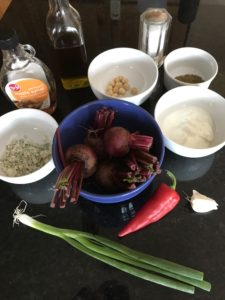
Ingredients:
- 2 lbs fresh beets (about 1 lb total after cooking and peeling)
- 2 cloves garlic, crushed
- 1 small red chile, seeded and finely chopped
- 1 cup Greek yogurt
- 5 T date (or maple) syrup
- 3 T olive oil, plus extra to finish the dish
- 1 T Za’atar
- Sea salt
To Garnish:
- 2 scallions, thinly sliced
- 2 T toasted hazelnuts, coarsely crushed*
- 2 oz soft goat cheese, crumbled
Directions:
- Preheat oven to 400F.
- Wash the beets and place in a roasting pan (lined with foil to help in clean up). Put them in oven and cook, uncovered, until a knife slides easily into the center, about 1 hour. Once they are cool enough to handle, peel and cut into about six pieces. Allow to cool down.
- Place the beets, garlic, chile and yogurt in a food processor and blend into a smooth paste. Transfer to a large mixing bowl and stir in the date syrup, olive oil, Za’atar, and 1 tsp sea salt. Taste and add more salt if you like.
- Transfer the mixture to a flat serving plate and use the back of a spoon to spread it around the plate. Scatter the scallions, hazelnuts and cheese on top, and finally drizzle with a bit of olive oil. Serve at room temperature.
*To toast hazelnuts: spread raw hazelnuts on a small roasting pan and bake at 350F in a toaster oven for about 10 minutes, watching that they don’t burn. While still hot, transfer to a clean dishtowel, fold up the towel over them, and rub the hazelnuts in the towel with your hands. This will remove the skins from the hazelnuts.
Gravlax with Dill Mustard Sauce
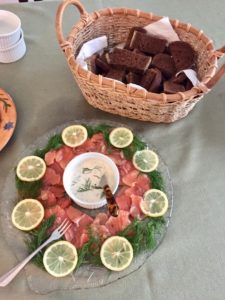
Gravlax means “grave salmon” as it was originally made by fisherman burying fish in sand above the high tide line and allowing it to ferment. It is now “buried” by weighing down a sandwich of two boned fillets that have been rubbed with a mix of salt and spices. Through osmosis, the liquid in the fish is drawn out, creating a salty brine which cures the fish.
Ingredients:
For the Gravlax:
- 2 skin-on, boneless fillets of very high quality, very fresh salmon (the two fillets should be as close as possible to equal size and thickness, 2-3 lbs total)
- 2 T fresh ground white pepper
- 1 T fresh ground juniper berries
- ¼ cup sea salt
- 1 bunch dill
- 3 T gin
For the Dill/Mustard sauce:
- 5 tsp dry mustard,
- 1 cup mayonnaise
- ¼ cup chopped fresh dill
- 2 T Dijon mustard,
- 1 T fresh lemon juice,
- 1 T gin
Directions:
- Rinse salmon fillets under cold running water and pat dry.
- Grind the white peppercorns and the juniper berries in a coffee grinder or spice grinder, then mix with the sea salt to make a rub.
- Rub each side of each fillet with the spice/salt mix, put one fillet skin side down and top with one whole bunch of fresh dill, saving about ¼ cup of dill to make a dill/mustard sauce later. Sprinkle with 3 T of gin, then top with the other fillet, skin side up.
- Put the fillet sandwich into a large ziplock bag. If your fillet sandwich is too large for the largest bag you have, cut it into two pieces across the width and put the two pieces into two bags. Close up the bag, forcing the air out as you do. Put on a plate or platter. Then find a board approximately the same size as the fish, and something to weight it down with, like a clean stone or heavy cans.
- Put it in the fridge for at least two or three days, flipping the fish over every 12 hours to ensure both fillets get equal time in the brine (it’s easier to put the plate or platter with the bagged fillet sandwich in the fridge first, then put the board and weight on it).
- After at least48 hours, remove the fish from the accumulated brine, toss out the dill (or save a little to use as a decorative garnish), and scrape off the spice rub. In what might seem to be counterintuitive, the longer the salmon cures in the brine, the mellower it gets.
- Put a fillet skin side down on a cutting board, and starting at the smaller tail end, use a fillet knife to make thin slices at a slant.
- Serve with rye or pumpernickel toast points and a dill/mustard sauce.
- To make the dill/mustard sauce, combine all of the ingredients listed above in a small bowl and mix well.
You can find an illustrated version of this recipe at: https://theperishablecook.com/gravlax/
Hi Kip, I had your chile verde at the OS farmer’s market. Can you share the recipe. I loved the one you made. The one I made last night, not so much.
Thanks!